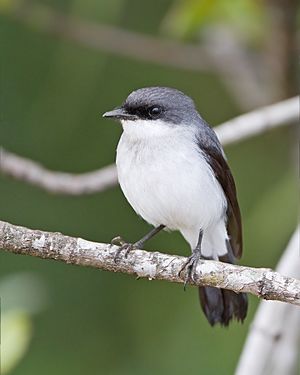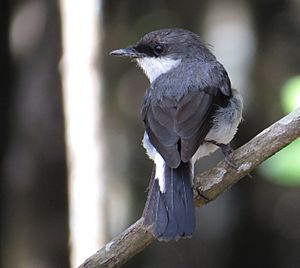Mangrove robin facts for kids
Quick facts for kids Mangrove robin |
|
|---|---|
 |
|
| In Cairns, Queensland, Australia | |
| Conservation status | |
| Scientific classification | |
| Subspecies | |
|
|
| Synonyms | |
|
The mangrove robin (Peneothello pulverulenta) is a small, dark bird. It belongs to the passerine group, which includes many songbirds. This bird is part of the robin family. You can find it in the Aru Islands, New Guinea, and northern Australia. The bird's common name comes from its home. It lives mostly in mangrove forests and rarely leaves these special tree areas.
Contents
About the Mangrove Robin's Family Tree
Scientists group living things into categories. This helps us understand how they are related. The mangrove robin was first described in 1850. A French naturalist named Charles Lucien Bonaparte gave it its first scientific name.
Later, an Australian bird expert, Gregory Mathews, moved it to a different group. Now, after new studies, it is placed in the Peneothello group. This shows how scientific understanding can change over time.
Mangrove Robin Subspecies
There are four main types, or subspecies, of the mangrove robin. They are slightly different depending on where they live:
- P. p. pulverulenta: Found along the coast of New Guinea.
- P. p. leucura: Lives in the Aru Islands and the northeast coast of Australia.
- P. p. alligator: Found along the coastal areas of northern Australia and nearby islands.
- P. p. cinereiceps: Lives on the northwest coast of Australia.
What Does the Mangrove Robin Look Like?
The mangrove robin is a small bird. Male birds usually weigh about 21.3 grams (0.75 oz). Females are a bit lighter, weighing around 17.3 grams (0.61 oz).
Their wingspan (how wide their wings are when spread) can be different. This depends on which subspecies they belong to:
- The leucura subspecies has wingspans of 86 millimetres (3.4 in) to 90 millimetres (3.5 in) for males. Females have wingspans of 77 millimetres (3.0 in) to 84 millimetres (3.3 in).
- The alligator subspecies has wingspans of 82 millimetres (3.2 in) to 87 millimetres (3.4 in) for males. Females have wingspans of 76 millimetres (3.0 in) to 80 millimetres (3.1 in).
- For the cinereiceps subspecies, males have wingspans of 80 millimetres (3.1 in) to 84 millimetres (3.3 in). Females have wingspans of 76 millimetres (3.0 in) to 78 millimetres (3.1 in).
These birds have a light bar on their wing feathers. However, it is not always easy to see. Mangrove robins have rounded wings and tails. This helps them fly easily through the thick branches of mangrove forests.
Where the Mangrove Robin Lives
The mangrove robin lives in Northern Australia and the island of New Guinea. This includes parts of Australia, Indonesia, and Papua New Guinea.
Mangrove Forest Homes
Their favorite homes are tropical and subtropical mangrove forests. These forests are special because they grow in salty water. The birds prefer areas above the high tide mark. They usually stay within these forests and do not travel far from them.
Conservation Status
The mangrove robin is listed as "least Concern" by the IUCN Red List. This means scientists are not worried about it disappearing. Its population has been stable for the last ten years. The area where it lives is very large, over 426,000 square kilometres (164,000 sq mi).
Mangrove Robin Behaviour
The call of the mangrove robin sounds like a "down-slurred whistle." It is a unique sound you might hear in the mangroves.
What Do They Eat?
When the tide goes out, these birds look for food in the mud. They mainly eat insects. But they also enjoy eating a lot of crabs. This diet helps them survive in their unique mangrove habitat.
See also
 In Spanish: Petroica de manglar para niños
In Spanish: Petroica de manglar para niños



